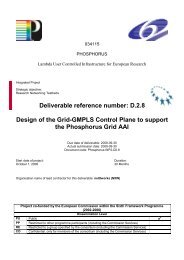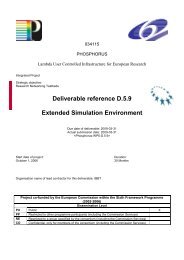Grid Job Routing Algorithms - Phosphorus
Grid Job Routing Algorithms - Phosphorus
Grid Job Routing Algorithms - Phosphorus
You also want an ePaper? Increase the reach of your titles
YUMPU automatically turns print PDFs into web optimized ePapers that Google loves.
<strong>Grid</strong> <strong>Job</strong> <strong>Routing</strong> <strong>Algorithms</strong>3 Introduction to <strong>Routing</strong> Protocols and<strong>Algorithms</strong><strong>Routing</strong> is a process of path determination and data forwarding for traffic going through a network. In simplenetworks, routing tables can be manually configured or identified from the configuration of interfaces on therouter. In more complex networks where a number of routers are arranged in a mesh topology, with a largenumber of links between them, each having different capabilities, manual configuration becomes difficult.However, more importantly there is a need to react dynamically to changes in the network especially in <strong>Grid</strong>environments e.g., when a link or router fails, we need to update all of the routing tables across the wholenetwork to take account of changes. Similar changes are desirable when failures are repaired or when newlinks and nodes are added. These dynamic processes complement <strong>Grid</strong> requirements for adjustablecommunication service parameters.For these purposes we rely on routing protocols to collate and distribute information about networkconnectivity, reachability, adjacency and optimization of paths by examining a range of variables related tonetwork conditions and configurations. The value of these parameters is provided to sophisticated routecalculation algorithms that can be run against the view of the network to determine the best path along which toforward traffic. Routers use Layer 3 addresses, e.g. IP, for identification of source and destination of packetsand have to determine out of which interface should a packet be sent, and on to which next hop (wheninterfaces lead to multi-access links), utilizing their routing tables which, comprise some form of look-upalgorithms that take an IP address and derive an interface identifier and a next hop address.The routing protocols that are used for routing table creation and allow routers to communicate with routingprotocol messages can be categorized into either distributed or centralized. In distributed protocols eachrouter in the network makes an independent routing decision based on available information whereas incentralized protocols routing decisions are made by a central node in the network and then are distributed toother nodes.Moreover there are two types of routing protocols: distance vector (including path vector) and link staterouting protocols. The distance vector protocol works by letting each node inform its neighbours about its bestProject:PHOSPHORUSDeliverable Number: D.5.3Date of Issue: 31/06/07EC Contract No.: 034115Document Code: <strong>Phosphorus</strong>-WP5-D5.314






